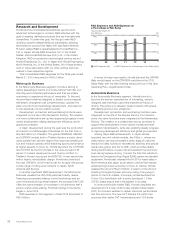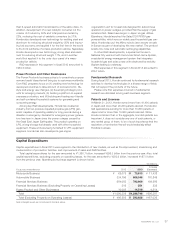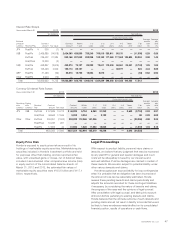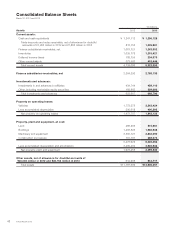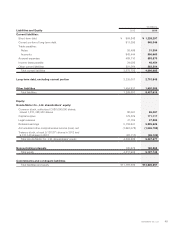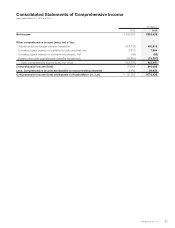Honda 2013 Annual Report Download - page 43
Download and view the complete annual report
Please find page 43 of the 2013 Honda annual report below. You can navigate through the pages in the report by either clicking on the pages listed below, or by using the keyword search tool below to find specific information within the annual report.
Credit losses are an expected cost of extending credit.
The majority of the credit risk is with consumer financing and
to a lesser extent with dealer financing. Credit risk can be
affected by general economic conditions. Adverse changes
such as a rise in unemployment rates can increase the likeli-
hood of defaults. Declines in used vehicle prices can reduce
the amount of recoveries on repossessed collateral. Credit
risk on dealer loans is affected primarily by the financial
strength of the dealers within the portfolio. Exposure to credit
risk is managed through purchasing standards, pricing of
contracts for expected losses, focusing collection efforts to
minimize losses, and ongoing reviews of the financial condi-
tions of dealers.
The allowance for credit losses is management’s estimate
of probable losses incurred on finance receivables. Estimated
losses on past due operating lease rental payments are also
recognized with an allowance for credit losses. In the case of
property on operating leases, estimated losses due to cus-
tomer defaults are not recognized in the allowance for credit
losses because a loss is realized upon the early disposition of
property. Therefore we present these losses as impairment
losses on property on operating leases. The allowance for
credit losses and impairment losses on operating leases are
based on evaluation of many factors, including our historical
credit loss experience, the value of the underlying collateral,
delinquency trends, and economic conditions.
Consumer finance receivables consist of a large number
of smaller-balance homogenous loans and leases and are
collectively evaluated for impairment. Our finance subsidiar-
ies utilize various methodologies when estimating the allow-
ance for credit losses including models that incorporate
vintage loss and delinquency migration analysis. The models
take into consideration attributes of the portfolio including
loan-to-value ratios, internal and external credit scores, and
collateral types. Economic factors such as used vehicle
prices, unemployment rates, and consumer debt service
burdens are also incorporated when estimating losses. The
methodologies and models used to estimate losses on oper-
ating leases are consistent with those used for consumer
finance receivables.
Wholesale receivables are considered to be impaired and
recognized in the allowance for credit losses when it is prob-
able that our finance subsidiaries will be unable to collect all
amounts due according to the original terms of the contract.
Wholesale receivables are evaluated for impairment on an
individual dealer basis. Ongoing evaluations of dealerships
are performed to determine whether there is evidence of
impairment. Factors can include payment performance,
overall dealership financial performance, or known difficulties
experienced by the dealership.
We believe our allowance for credit losses and impairment
losses on operating leases is a “critical accounting estimate”
because it requires significant judgment about inherently
uncertain items. We regularly review the adequacy of the
allowance for credit losses and impairment losses on operat-
ing leases. The estimates are based on information available
as of each reporting date. However actual losses may differ
from the original estimates as a result of actual results varying
from those assumed in our estimates.
As an example of the sensitivity of the allowance calcula-
tion, the following scenario demonstrates the impact that a
deviation in one of the primary factors estimated as a part of
our allowance calculation would have on the provision and
allowance for credit losses. If we had experienced a 10%
increase in net credit losses during fiscal 2013, the provision
for fiscal 2013 and the allowance balance at the end of fiscal
2013 would have increased by approximately ¥3.2 billion and
¥1.9 billion, respectively. Note that this sensitivity analysis
may be asymmetric, and are specific to the base conditions
in fiscal 2013.
Additional Narrative of the Change in Credit Loss
The following tables summarize our allowance for credit losses on finance receivables:
Yen (billions)
For the year ended March 31, 2012 Retail
Direct
financing lease Wholesale Total
Allowance for credit losses
Balance at beginning of year ¥ 25.5 ¥ 1.4 ¥ 1.4 ¥ 28.4
Provision 10.3 0.3 0.0 10.8
Charge-offs (21.1) (0.7) (0.0) (21.9)
Recoveries 6.6 0.1 0.0 6.8
Adjustments from foreign currency translation (0.9) (0.0) (0.0) (1.0)
Balance at end of year ¥ 20.4 ¥ 1.1 ¥ 1.4 ¥ 23.0
Ending receivable balance ¥3,328.1 ¥380.3 ¥301.3 ¥4,009.8
Average receivable balance, net ¥3,233.1 ¥366.1 ¥243.7 ¥3,843.0
Net charge-offs as a % of average receivable balance 0.45% 0.16% 0.03% 0.39%
Allowance as a % of ending receivable balance 0.62% 0.30% 0.46% 0.57%
Honda Motor Co., Ltd. 41







